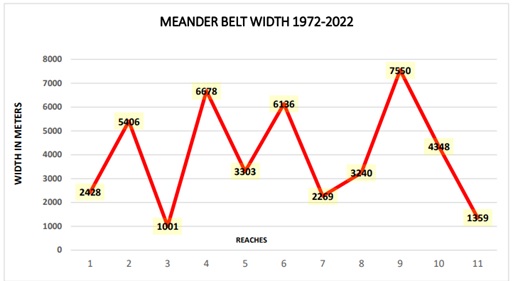A Detecting Land Use Land Cover Changes Induced by the Dynamics of River Indus, Pakistan, from 1972 -2022, Using Remote Sensing and GIS Techniques
Keywords:
Indus River Shifting, Land Use and Land Cover (LULC), Geographic Information System (GIS), Remote Sensing (RS), Erosion and Accretion Patterns, Flood Management, Socio-Economic Impact.Abstract
Introduction/Importance of Study: This study evaluates the shifting of the Indus River and its impact on land use and land cover from 1972 to 2022 using Geographic Information System (GIS) and Remote Sensing (RS) techniques.
Novelty Statement: This research uniquely addresses the intricate relationship between river shifting and LULC changes, providing new insights into flood management and land use planning. Chronic alluvium erosion due to the river's fast flow has led to poverty among residents and annual national asset losses, affecting the economy.
Material and Method: Using satellite images from 1972 to 2022, the research employed GIS and remote sensing techniques to analyse river sinuosity, channel migration, erosion, and accretion patterns, along with LULC changes. Methods included calculating the Indus River's sinuosity index, assessing channel and bank migration, and applying the Normalized Difference Water Index and maximum likelihood classification for accurate LULC assessment.
Result and Discussion: Long-term results indicated that river erosion influenced land area, increasing settlement areas, decreasing vegetation, and causing fluctuations in barren land, water bodies, and agricultural land. Built-up areas expanded considerably, indicating population growth in floodplains. Erosion and deposition have notably affected agricultural and settlement areas, leading to socio-economic stress and internal migration. Satellite images taken during spring and dry seasons (March to May) showed minimal stream flow due to lower rainfall. Maximum erosion and management plans are critical for Reaches A, B, C, H, I, and J from 1972 to 2022. Minor embankment improvements are necessary for these reaches, as initial migration occurred on the right side for Reaches A, B, and C, shifted to the left from D to G, and affected both sides from H to J.
Concluding Remark: This research highlights how important GIS and remote sensing are for studying river changes and their effects on land use. It provides valuable information to help make better decisions about managing floods and planning land use.
References
Tariq, A., Shu, H., Kuriqi, A., Siddiqui, S., Gagnon, A. S., Lu, L., Linh, N. T. T., & Pham, Q. B. (2021). Characterization of the 2014 Indus river flood using hydraulic simulations and satellite images. Remote Sensing, 13(11), 2053.
Kumar, A., & Srivastava, P. (2018). Landscape of the indus river. The Indian Rivers: Scientific and Socio-economic Aspects, 47-59.
Raza, D., & Kidwai, A. A. (2018). Geospatial analysis of Indus River meandering and flow pattern from Chachran to Guddu Barrage, Pakistan. RADS Journal of Biological Research & Applied Sciences, 9(2), 67-74.
Orengo, H. A., Knappett, C., & Knappett, C. (2018). Toward a definition of Minoan agro-pastoral landscapes: results of the survey at Palaikastro (Crete). American Journal of Archaeology, 122(3), 479-507.
Dave, A. K., Courty, M.-A., Fitzsimmons, K. E., & Singhvi, A. K. (2019). Revisiting the contemporaneity of a mighty river and the Harappans: Archaeological, stratigraphic and chronometric constraints. Quaternary Geochronology, 49, 230-235.
Mahar, G. A., & Zaigham, N. A. (2015). Examining spatio-temporal change detection in the Indus River Delta with the help of satellite data. Arabian Journal for Science and Engineering, 40, 1933-1946.
Qureshi, M. N. (2021). Utilization of Natural Resources of Pakistan Quaid I Azam University].
Inam, A., Clift, P. D., Giosan, L., Alizai, A., Kidwai, S., Shahzad, M. I., Zia, I., Nazeer, M., Khan, M. J., & Ali, S. S. (2022). The geographic, geological, and oceanographic setting of the Indus river–an update. Large Rivers: Geomorphology and Management, Second Edition, 488-520.
Chakraborty, S. K. (2021). Riverine Ecology Volume 1: Eco-functionality of the Physical Environment of Rivers. Springer Nature.
Mueller, J. E. (1968). An introduction to the hydraulic and topographic sinuosity indexes. Annals of the association of american geographers, 58(2), 371-385.
Twisa, S., & Buchroithner, M. F. (2019). Land-use and land-cover (LULC) change detection in Wami River Basin, Tanzania. Land, 8(9), 136.
Lambin, E. F., Turner, B. L., Geist, H. J., Agbola, S. B., Angelsen, A., Bruce, J. W., Coomes, O. T., Dirzo, R., Fischer, G., & Folke, C. (2001). The causes of land-use and land-cover change: moving beyond the myths. Global environmental change, 11(4), 261-269.
Roy, N., & Sinha, R. (2018). Integrating channel form and processes in the Gangetic plains rivers: Implications for geomorphic diversity. Geomorphology, 302, 46-61.
Lin, Y., Zhang, L., Wang, N., Zhang, X., Cen, Y., & Sun, X. (2020). A change detection method using spatial-temporal-spectral information from Landsat images. International Journal of Remote Sensing, 41(2), 772-793.
Mamun, A., & Sobnam, M. (2021). Dynamics of Dharla River in Bangladesh relation to sinuosity and braiding: GIS-RS based spatial investigation. J. Appl. Geol. Geophys, 9(4), 50-56.

Downloads
Published
How to Cite
Issue
Section
License
Copyright (c) 2024 50sea

This work is licensed under a Creative Commons Attribution 4.0 International License.




















